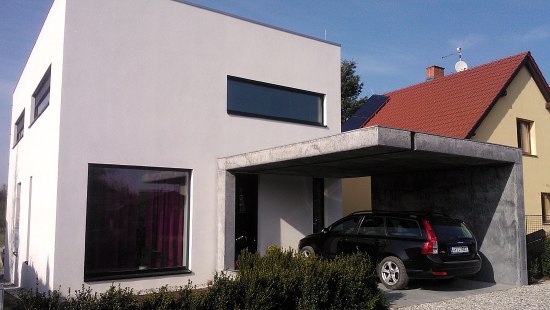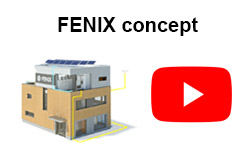Detached house in Pilsen II.

The low-energy house with a total living area of 205.1 m², located on the outskirts of Pilsen, was classified as category "B" in the PENB (according to Decree. 148/2007 Coll.), but its construction parameters and energy values are already close to category "A". Therefore, electric heating was chosen as the main heating system.
Technical parameters of the object
The detached house itself is designed as a three-floor building with the following habitable area dimensions: basement – 50.92 m², ground floor – 76.55 m², first floor – 77.63 m². The author of this project, who is also the investor in this detached house, is a professional architect. We have therefore respected his wish not to represent either the layout or more detailed information about its construction. Nevertheless, we can briefly say about the building that the vertical peripheral structures are made from 175 mm-thick KALKSANDSTEIN sand lime blocks, thermally insulated by 300 mm-thick NEOPOR façade grey polystyrene foam. The horizontal structures feature a load-bearing slab made of 40 mm-thick fibre concrete, thermally insulated by ISOVER NEOFLOOR 100 floor polystyrene (200 mm-thick over the ground, 50 mm-thick on the ground and first floor). The roof structure is insulated with 450 mm-thick XPS STYRODUR C; aluminium-framed SHÜCO windows with insulating triple glazing were used for the filling of openings (windows).
Construction was completed in August 2013 and the family has been using the house fully since then. The building is inhabited by a four-member family, and the household only uses one form of energy for its operation – electricity. The heating of warm water is provided by a Buderus unit of the Logatherm WPT 270 l-S type which contains an integrated air/water pump. The air exchange is forced, with an EHR 325 Ekonovent heat recovery unit – a ventilation unit featuring heat recovery but without additional heating – the unit doesn´t have an integrated heating element.
The value of the main circuit breaker is 3x25A. In order that such a low main circuit breaker value can be achieved, a BMR HJ-306 current controller has been installed which disconnects the heating circuits in two priorities if needed. The house tariff is D 45, and ČEZ is the energy supplier.
Heating system
The builder and also author of the project placed great emphasis not only on the architectural design of the house and the layout of the inside areas, but also on the design of details. The option of installing a heating source within the structure of the building, leaving the heated area absolutely pure and free of distracting technical elements, was very important in the selection of the type of heating to use. Other important criteria for the selection of a heating system were economy, lifespan and comfort, of course. The decision was made to install a large-surface electric direct-heating system; apart from the previously-mentioned design consideration, the reasons for this choice can be summed up in the following five points:
-
minimisation of operating costs
-
minimisation or complete elimination of maintenance and service costs
-
maximisation of lifespan, including the warranty period
-
maximisation of heating comfort from the perspective of warmth perception
-
minimisation of investment costs
After evaluating the options available on the market, the investor chose ECOFLOOR large-surface systems. The heat source takes the form of atypical cable mats which are laid on thermal insulation under the load-bearing slab – this is a so-called semi-storage system. There are zero requirements for special maintenance with this system: maintenance and service is the same as is in the case of standard domestic electrical wiring.
The selected large-surface ECOFLOOR system also provides the required user comfort and even distribution of temperatures across the whole temperature spectrum. In the case of standard central heating, when the room is heated with a warm-water radiator, distribution of heat takes place from one source with a relatively high temperature and the heat spreads into the room via warm air circulation. The room is thus heated from the ceiling downwards and the heat is distributed unevenly. This principle is characteristic of all convection systems – including electric direct-heating convectors.
As heating is a matter of feeling, we only feel comfortable in a heated area when the required temperature is also reached near the floor because we perceive the heat there most sensitively of all. In the case of convection systems, the room is the warmest where the heat is not needed at all – i.e. near the ceiling. In order to achieve the required comfort temperature near the floor, it is necessary to "overheat" the room, which is undesirable at the very least from the economic point of view.
Large-surface heating systems (floor and ceiling) eliminate this negative point completely because they guarantee an even distribution of temperatures both horizontally and vertically within the room – this ensures not only high user comfort but also low operating costs.
Floor heating is particularly pleasant when cold floor coverings are used, such as floor tiling, laminate floating floors, etc., and it is quite commonly used these days – it is a standard feature particularly in bathrooms. The ECOFLOOR range offers a choice of many product groups and has the widest selection on the market. It differs from warm water-based floor heating in the very low investment cost for the heating system and its installation. This was another of the main reasons for the selection of electricity as the main source of warmth.
Selection of regulation system
The choice of regulation has a significant influence on operating costs. There is a wide range of thermostats of differing designs, versions and price levels on the market but they are usually standard thermostats which do not meet the requirement for the saving of operating costs – the regulation of heating takes place only in the on/off modes. Therefore, the BMR RT-64 regulation system with pulse performance management was selected.
In the case of this regulation system, all programming (of temperature and time) is carried out on a single central control unit via a PC and if the unit is connected to a local computer network (router), this can also be performed remotely via a tablet, smartphone or notebook. The heating output is controlled via power semiconductors – i.e., in a contact-free manner, and therefore completely silently. There are just temperature sensors in the individual rooms. The design of the room sensors can be adapted to suit other switches and sockets in the room, or they can be placed into shared frames. Thanks to pulse performance management and the high precision of set temperature maintenance, BMR regulation provides energy consumption savings of up to 30% compared with standard room thermostats. The quality of BMR regulation is also guaranteed by a five-year warranty period provided by the manufacturer.
Acquisition costs
The following chart shows the acquisition costs for the whole system, including the BMR central regulation system.
| Heat loss of the building [W] |
ECOFLOOR system price |
BMR regulation price |
Total price |
|---|---|---|---|
| 4 697 | 49.270 | 37.284 | 86.554 |
Operating costs
Apart from the main electricity meter, which was fitted by the electricity supplier, a secondary electricity meter for the measurement of electricity consumption for the heating of the building was also installed in the house. After an agreement with the user, the building will be monitored on a long-term basis and the following chart will be filled in over time.
| Period | Total consumption | Consumption fo heating | CZK including VAT | |
|---|---|---|---|---|
| LT (kWh) | HT (kWh) | (kWh) | ||
| 06/2013 - 06/2014 | 9 663 | 1 941 | 5 515 | 35.722 |
| 06/2014 - 06/2015 | 10 484 | 2 202 | 5 772 | 36.050 |
| 06/2015 - 06/2016 | 10 284 | 1 844 | 5 607 | 34.735 |
| 06/2016 - 06/2017 | 11 183 | 2 008 | 6 313 | 37.394 |
| 06/2018 - 06/2019 | 10 770 | 2 006 | 4 247 | 39 919,- |
| 06/2019 - 06/2020 | 11 018 | 1 989 | 4 487 | 45 978,- |
| 06/2020 - 06/2021 | 12 440 | 2 258 | 5 306 | 49 765,- |
| 06/2021 - 06/2022 | 11 357 | 2 094 | 4 632 | 56 527,- |
|
06/2022 - 02/2023 (8 months) |
7 418 | 1 392 | 3 612 | 47 654,- |
At the turn of 2022 and 2023, a small home of photovoltaic power plant system with an output of 9.79 kWp was installed on the house, supplemented by a battery storage with a nominal capacity of 14.2 kWh. After deducting the subsidy from the New Green Savings Programme of CZK 210 000, the investment amounted to CZK 250 000. The Photovoltaic power plant was put into operation on 20.2 2023, therefore an extraordinary billing was made on that date, the consumption for 06/2022 to 02/2023 therefore presents only 8 calendar months. The billing from 03/2023 onwards already reflects the effect of the photovoltaic plant.







